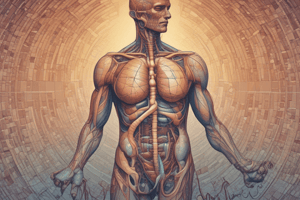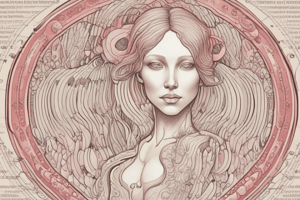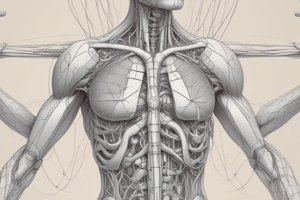Podcast
Questions and Answers
What is the function of the testes?
What is the function of the testes?
- Transport sperm
- Storage of eggs
- Support uterus
- Produce testosterone and sperm (correct)
What does the tunica albuginea do?
What does the tunica albuginea do?
Covers testis and divides testis into compartments.
What is the primary function of the scrotum?
What is the primary function of the scrotum?
- Support the uterus
- To keep the temperature of the testes slightly lower than the body (correct)
- Secrete fluids
- Store sperm
What is stored in the epididymis?
What is stored in the epididymis?
The ductus deferens is involved in transporting sperm to the urethra.
The ductus deferens is involved in transporting sperm to the urethra.
What structures are contained within the spermatic cord?
What structures are contained within the spermatic cord?
What is the function of the ejaculatory duct?
What is the function of the ejaculatory duct?
What do seminal vesicles secrete?
What do seminal vesicles secrete?
What is the purpose of the prostate gland?
What is the purpose of the prostate gland?
What does the external urethral orifice do?
What does the external urethral orifice do?
What are the primary functions of the ovaries?
What are the primary functions of the ovaries?
What is the function of the fimbria of oviducts?
What is the function of the fimbria of oviducts?
What does the uterus do?
What does the uterus do?
What is the main function of the vagina rugae?
What is the main function of the vagina rugae?
What is the function of the labia majora?
What is the function of the labia majora?
What role does the perineum play?
What role does the perineum play?
The cervical canal secretes mucus to prevent the spread of bacteria from the vagina.
The cervical canal secretes mucus to prevent the spread of bacteria from the vagina.
Flashcards are hidden until you start studying
Study Notes
Male Reproductive System
- Testes: Produce testosterone and sperm, essential for male reproductive functions.
- Tunica Albuginea: Covers the testes and divides them into 250-300 compartments, each containing 1-4 seminiferous tubules.
- Scrotum: Maintains a slightly lower temperature for testes, crucial for sperm production.
- Epididymis: Stores sperm and facilitates its secretion into the duct during ejaculation.
- Ductus Deferens (Vas Deferens): Transports sperm from the epididymis to the urethra.
- Spermatic Cord: Located in the inguinal canal and scrotum; contains ductus deferens, testicular vessels, and nerves.
- Inguinal Canal: Pathway through the abdominal wall for spermatic cord.
- Ejaculatory Duct: Site where sperm mixes with seminal fluid before entering the prostatic urethra.
- Seminal Vesicles: Secretes fluid that forms a significant part of semen.
- Prostate Gland: Produces a milky fluid contributing to 20-30% of semen volume.
- Urethra (Prostatic, Membranous, Spongy): Common passage for urine and semen in males.
- External Urethral Orifice: Exit point for semen and urine from the body.
- Bulbourethral Glands: Secrete mucus that neutralizes urine acidity and lubricates the urethra during sexual arousal.
- Penis: Serves to deliver sperm to the vagina and functions as a urinary conduit.
- Corpus Spongiosum: Prevents urethra constriction, maintaining an open channel for ejaculation.
- Corpora Cavernosum: Facilitate penile erection during sexual arousal.
- Glans Penis: Potentially aids in sperm removal from rivals and increases stimulation for females.
- Prepuce (Foreskin): Protects the glans penis and the urinary meatus.
Female Reproductive System
- Ovaries: Store and release eggs, also produce hormones.
- Oviducts (Uterine/Fallopian Tubes): Transport ova from ovaries to uterus; environment for fertilization.
- Infundibulum: Captures released eggs from ovaries and directs them to the oviducts.
- Fimbria: Help guide eggs into the infundibulum of the oviduct.
- Uterus: Houses and supports a fertilized ovum, accommodating fetal growth.
- Fundus of Uterus: The upper portion of the uterus.
- Cervix: Serves as the exit for menstrual flow/birth; remains closed during pregnancy.
- Body of Uterus: Main section for accommodating the growing fetus.
- Endometrium: Lining of the uterus that prevents adhesions and serves as the implantation site.
- Myometrium: Muscular layer that contracts during childbirth.
- Perimetrium: Provides support to the uterus and routes for vessels and nerves.
- Cervical Canal: Secretes mucus to block bacteria from entering the uterus.
- Vaginal Rugae: Allow for expansion of the vagina during childbirth.
- Mons Pubis: Provides cushioning and protection to the pubic area.
- Labia Majora and Minora: Protective structures for internal vaginal components.
- Clitoral Prepuce: Protects the glans of the clitoris.
- Vestibule: Houses the vaginal opening and external urethral orifice.
- External Urethral Orifice: Exit for urine.
- Vaginal Orifice: Opening of the vagina.
- Perineum: Supports abdominal and pelvic organs; involved in sexual functions and childbirth.
- Urogenital Diaphragm: Functions as a sphincter controlling urine flow.
Studying That Suits You
Use AI to generate personalized quizzes and flashcards to suit your learning preferences.




